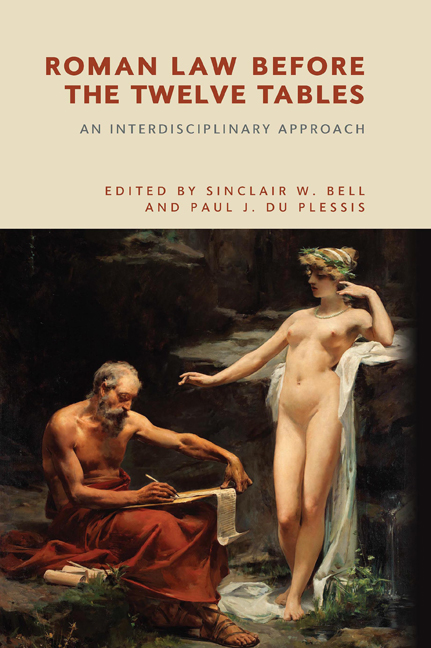82 results
Introduction: The Dawn of Roman Law
-
-
- Book:
- Roman Law before the Twelve Tables
- Published by:
- Edinburgh University Press
- Published online:
- 22 September 2020
- Print publication:
- 31 March 2020, pp 1-6
-
- Chapter
- Export citation

Roman Law before the Twelve Tables
- An Interdisciplinary Approach
-
- Published by:
- Edinburgh University Press
- Published online:
- 22 September 2020
- Print publication:
- 31 March 2020
The Contributors
-
- Book:
- Roman Law before the Twelve Tables
- Published by:
- Edinburgh University Press
- Published online:
- 22 September 2020
- Print publication:
- 31 March 2020, pp vii-viii
-
- Chapter
- Export citation
Frontmatter
-
- Book:
- Roman Law before the Twelve Tables
- Published by:
- Edinburgh University Press
- Published online:
- 22 September 2020
- Print publication:
- 31 March 2020, pp i-iv
-
- Chapter
- Export citation
Contents
-
- Book:
- Roman Law before the Twelve Tables
- Published by:
- Edinburgh University Press
- Published online:
- 22 September 2020
- Print publication:
- 31 March 2020, pp v-vi
-
- Chapter
- Export citation
Index
-
- Book:
- Roman Law before the Twelve Tables
- Published by:
- Edinburgh University Press
- Published online:
- 22 September 2020
- Print publication:
- 31 March 2020, pp 199-205
-
- Chapter
- Export citation
Part II - Constructing Early Roman Law: Sources and Methods
-
- Book:
- Roman Law before the Twelve Tables
- Published by:
- Edinburgh University Press
- Published online:
- 22 September 2020
- Print publication:
- 31 March 2020, pp 55-56
-
- Chapter
- Export citation
Part I - The Materiality of Roman Law: New Archaeological Discoveries
-
- Book:
- Roman Law before the Twelve Tables
- Published by:
- Edinburgh University Press
- Published online:
- 22 September 2020
- Print publication:
- 31 March 2020, pp 7-8
-
- Chapter
- Export citation
Part III - Roman Law in Historiography and Theory
-
- Book:
- Roman Law before the Twelve Tables
- Published by:
- Edinburgh University Press
- Published online:
- 22 September 2020
- Print publication:
- 31 March 2020, pp 153-154
-
- Chapter
- Export citation
Disqualified Witnesses Between Tannaitic Halakha and Roman Law: A Response to Orit Malka
-
- Journal:
- Law and History Review / Volume 37 / Issue 4 / November 2019
- Published online by Cambridge University Press:
- 06 November 2019, pp. 947-954
- Print publication:
- November 2019
-
- Article
- Export citation
4 - Jacques de Revigny
-
-
- Book:
- Great Christian Jurists in French History
- Published online:
- 10 May 2019
- Print publication:
- 16 May 2019, pp 71-84
-
- Chapter
- Export citation
A Festschrift for Bruce Frier on ancient law and society - DENNIS P. KEHOE and THOMAS A. J. McGINN (edd.), ANCIENT LAW, ANCIENT SOCIETY (University of Michigan Press, Ann Arbor, MI2017). Pp. ix + 216. ISBN 978-0-472-13043-6. $70.
-
- Journal:
- Journal of Roman Archaeology / Volume 32 / 2019
- Published online by Cambridge University Press:
- 11 October 2019, pp. 648-655
- Print publication:
- 2019
-
- Article
- Export citation
Contents
-
- Book:
- Wrongful Damage to Property in Roman Law
- Published by:
- Edinburgh University Press
- Published online:
- 28 April 2021
- Print publication:
- 15 May 2018, pp v-v
-
- Chapter
- Export citation
Part I - Matters of Context
-
- Book:
- Wrongful Damage to Property in Roman Law
- Published by:
- Edinburgh University Press
- Published online:
- 28 April 2021
- Print publication:
- 15 May 2018, pp 1-2
-
- Chapter
- Export citation
Part II - Case Studies
-
- Book:
- Wrongful Damage to Property in Roman Law
- Published by:
- Edinburgh University Press
- Published online:
- 28 April 2021
- Print publication:
- 15 May 2018, pp 161-162
-
- Chapter
- Export citation

Wrongful Damage to Property in Roman Law
- British perspectives
-
- Published by:
- Edinburgh University Press
- Published online:
- 28 April 2021
- Print publication:
- 15 May 2018
Index
-
- Book:
- Wrongful Damage to Property in Roman Law
- Published by:
- Edinburgh University Press
- Published online:
- 28 April 2021
- Print publication:
- 15 May 2018, pp 279-283
-
- Chapter
- Export citation
10 - Conclusions
-
-
- Book:
- Wrongful Damage to Property in Roman Law
- Published by:
- Edinburgh University Press
- Published online:
- 28 April 2021
- Print publication:
- 15 May 2018, pp 275-278
-
- Chapter
- Export citation
Frontmatter
-
- Book:
- Wrongful Damage to Property in Roman Law
- Published by:
- Edinburgh University Press
- Published online:
- 28 April 2021
- Print publication:
- 15 May 2018, pp i-iv
-
- Chapter
- Export citation
Preface
-
-
- Book:
- Wrongful Damage to Property in Roman Law
- Published by:
- Edinburgh University Press
- Published online:
- 28 April 2021
- Print publication:
- 15 May 2018, pp vii-viii
-
- Chapter
- Export citation



